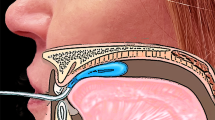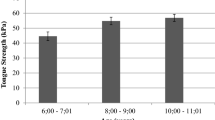Abstract
Muscular hypotonia is a feature of Down syndrome (DS), and it affects the tongue and lips. A study on oral dysfunction in children with DS concluded that most of them did not have the tongue strength for completing the oral phase of swallowing. Recognizing the weakness of the oral muscles and improving its motor function positively affects mastication and swallowing, and prevents complications. This cross-sectional study aimed to measure the lip and tongue strength and endurance of children with DS and their typical peers, and compare these two groups with each other using Iowa Oral Performance Instrument (IOPI). Eight children with DS and 33 typical children aged 8–13 years were enrolled in this study. To examine the effect of age on the tongue strength and endurance, we divided the children into three groups of 8–9, 10–11, and 12–13 years old. The results showed that both anterior and posterior tongue strength were significantly lower in children with DS (p = 0.004 and 0.003). But, it was not the case with tongue endurance. Also, in 10–11 years old age group, the mean posterior tongue strength and in 12–13 years old age group the lip endurance was significantly lower in children with DS (p = 0.05 for both). Lips strength and endurance were both remarkably lower in children with DS (p = 0.004 and 0.02). In this study, tongue, and lip strength and endurance in both children with DS and typical ones were measured with IOPI for the first time. Moreover, it provided quantitative data on the strength and endurance of the muscles of the tongue and lips, which can contribute to future studies.

Similar content being viewed by others
References
Antonarakis SE, Skotko BG, Rafii MS, Strydom A, Pape SE, Bianchi DW, Sherman SL, Reeves RH. Down syndrome. Nat Rev Dis Primers. 2020;6(1):9. https://doi.org/10.1038/s41572-019-0143-7.
Faulks D, Collado V, Mazille MN, Veyrune JL, Hennequin M. Masticatory dysfunction in persons with Down’s syndrome. Part 1: aetiology and incidence. J Oral Rehabil. 2008;35(11):854–62.
Kaczorowska N, Kaczorowski K, Laskowska J, Mikulewicz M. Down syndrome as a cause of abnormalities in the craniofacial region: a systematic literature review. Adv Clin Exp Med. 2019;28(11):1587–92. https://doi.org/10.17219/acem/112785.
Frazier JB, Friedman B. Swallow function in children with Down syndrome: a retrospective study. Dev Med Child Neurol. 1996;38(8):695–703.
Farpour S, Farpour HR, Smithard D, Kardeh B, Ghazaei F, Zafarghasempour M. Dysphagia management in Iran: knowledge, attitude and practice of healthcare providers. Dysphagia. 2019;34(1):105–11. https://doi.org/10.1007/s00455-018-9919-2.
Hashimoto M, Igari K, Hanawa S, Ito A, Takahashi A, Ishida N, Koyama S, Ono T, Sasaki K. Tongue pressure during swallowing in adults with down syndrome and its relationship with palatal morphology. Dysphagia. 2014;29(4):509–18.
Dodds WJ. Physiology of swallowing. Dysphagia. 1989;3(4):171–8. https://doi.org/10.1007/bf02407219.
Gisel EG, Lange LJ, Niman CW. Chewing cycles in 4- and 5-year-old Down’s syndrome children: a comparison of eating efficacy with normals. Am J Occup Ther. 1984;38(10):666–70.
Anil MA, Shabnam S, Narayanan S. Feeding and swallowing difficulties in children with Down syndrome. J Intellect Disabil Res. 2019;63(8):992–1014. https://doi.org/10.1111/jir.12617.
Hohoff A, Ehmer U. Short-term and long-term results after early treatment with the Castillo Morales stimulating plate. J Orofac Orthop/Fortschr Kieferorthop. 1999;60(1):2–12.
Korbmacher H, Limbrock J, Kahl-Nieke B. Long-term evaluation of orofacial function in children with Down syndrome after treatment with a stimulating plate according to Castillo Morales. J Clin Pediatr Dent. 2006;30(4):325–8.
The Iowa Oral Performance Instrument (IOPI) (2020). https://iopimedical.com/medical-professionals/. Accessed 12 July 2020.
Rafii MS, Kleschevnikov AM, Sawa M, Mobley WC. Down syndrome. Handb Clin Neurol. 2019;167:321–36. https://doi.org/10.1016/b978-0-12-804766-8.00017-0.
Center for Disease Control and Prevention. Data and statistics on Down syndrome. CDC; 2020. https://www.cdc.gov/ncbddd/birthdefects/downsyndrome.html. Accessed 18 July 2020.
Gisel EG, Lange LJ, Niman CW. Tongue movements in 4- and 5-year-old Down’s syndrome children during eating: a comparison with normal children. Am J Occup Ther. 1984;38(10):660–5.
Potter NL, Short R. Maximal tongue strength in typically developing children and adolescents. Dysphagia. 2009;24(4):391.
Jackson A, Maybee J, Moran MK, Wolter-Warmerdam K, Hickey F. Clinical characteristics of dysphagia in children with Down syndrome. Dysphagia. 2016;31(5):663–71.
Smith CH, Teo Y, Simpson S. An observational study of adults with Down syndrome eating independently. Dysphagia. 2014;29(1):52–60.
Mckay R, Smart S, Cocks N. Investigating tongue strength and endurance in children aged 6 to 11 years. Dysphagia. 2019;35(5):1–11.
Smith A, Zelaznik HN. Development of functional synergies for speech motor coordination in childhood and adolescence. Dev Psychobiol. 2004;45(1):22–33.
Crow HC, Ship JA. Tongue strength and endurance in different aged individuals. J Gerontol A. 1996;51(5):M247–50.
Vanderwegen J, Guns C, Van Nuffelen G, Elen R, De Bodt M. The influence of age, sex, bulb position, visual feedback, and the order of testing on maximum anterior and posterior tongue strength and endurance in healthy Belgian adults. Dysphagia. 2013;28(2):159–66.
Acknowledgements
This manuscript was a part of Zhila Mohammadian's (No. 15511) Thesis approved by the Vice-Chancellor of Research, Shiraz University of Medical Sciences, Shiraz, Iran. Furthermore, the study method was approved by the Medical Ethics Committee of Shiraz University of Medical Sciences (SUMS) with the Reference Number “IR.SUMS.MED.REC.1398.134”. The authors would like to thank the Center for Developing Clinical Research of Nemazee Hospital and Dr. Nasrin Shokrpour and the Research Consultation Center (RCC) of Shiraz University of Medical Sciences, Shiraz, Iran, for editorial assistance. The authors would also like to thank the Research Consultation Center (RCC) of Shiraz University of Medical Sciences, Shiraz, Iran, for statistical analysis and Dr. Mohammad Jafari and Dr. Elahe Sohbat for their assistance.
Author information
Authors and Affiliations
Corresponding author
Ethics declarations
Conflict of interest
The authors have no conflict of interest to declare.
Additional information
Publisher's Note
Springer Nature remains neutral with regard to jurisdictional claims in published maps and institutional affiliations.
Rights and permissions
About this article
Cite this article
Farpour, H., Moosavi, S.A., Mohammadian, Z. et al. Comparing the Tongue and Lip Strength and Endurance of Children with Down Syndrome with Their Typical Peers Using IOPI. Dysphagia 37, 966–972 (2022). https://doi.org/10.1007/s00455-021-10359-4
Received:
Accepted:
Published:
Issue Date:
DOI: https://doi.org/10.1007/s00455-021-10359-4




